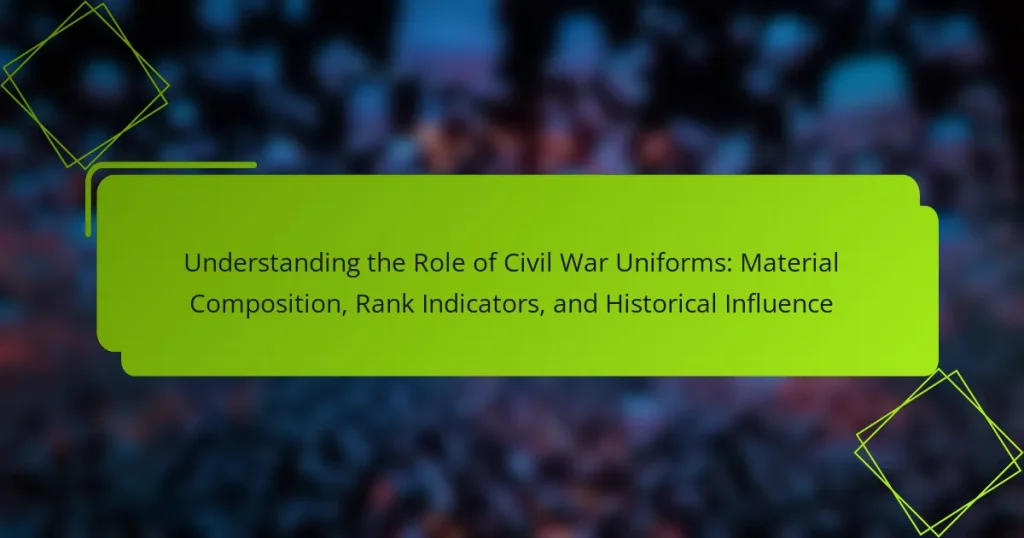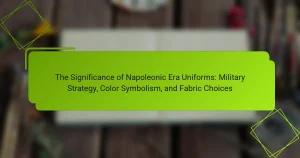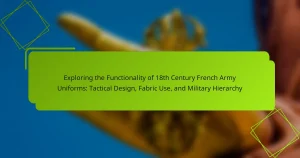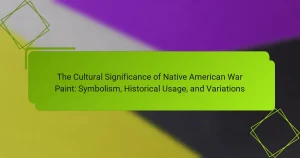Civil War uniforms were standardized clothing worn by soldiers during the American Civil War from 1861 to 1865, serving purposes such as identification, unity, and discipline. These uniforms featured distinct colors, with Union soldiers in blue and Confederate soldiers in gray, which helped reduce friendly fire and foster morale. The article explores the historical significance of these uniforms, their influence on military attire and American cultural identity, and the materials used in their construction. It also examines rank indicators and suggests methods for studying the uniforms, including visits to museums and engagement with primary sources, to gain a deeper understanding of their impact on society and military organization.
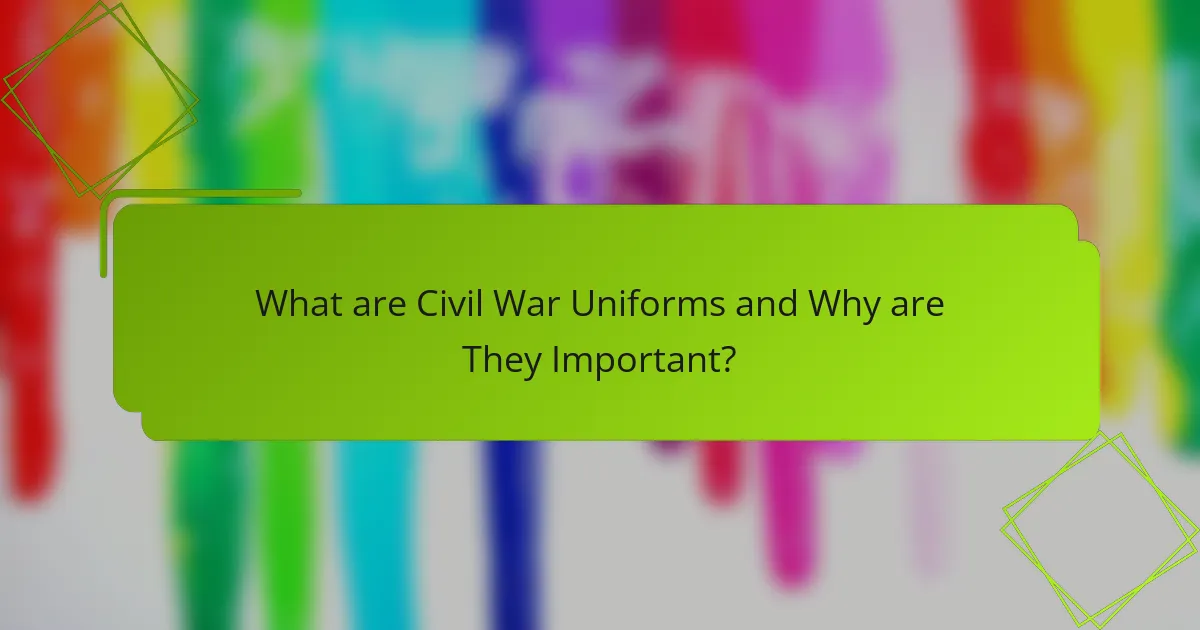
What are Civil War Uniforms and Why are They Important?
Civil War uniforms are the standardized clothing worn by soldiers during the American Civil War, from 1861 to 1865. They served multiple purposes, including identification, unity, and discipline among troops. The uniforms typically featured distinct colors and designs to differentiate between Union and Confederate forces. For example, Union soldiers primarily wore blue, while Confederate soldiers wore gray.
These uniforms were important for several reasons. They fostered a sense of belonging and morale among soldiers. Additionally, they played a crucial role in battlefield recognition, reducing friendly fire incidents. The design and material of the uniforms also reflected the resources available and the manufacturing capabilities of the time.
Historically, Civil War uniforms have influenced military attire in subsequent conflicts. They are now considered significant artifacts that represent the struggles and sacrifices of that era. The study of these uniforms provides insights into social, economic, and political aspects of the Civil War period.
How did Civil War Uniforms evolve over time?
Civil War uniforms evolved significantly from the early stages of the conflict to its conclusion. Initially, uniforms varied widely in color and design among both Union and Confederate forces. The Union adopted a more standardized dark blue wool uniform in 1861, which became iconic. Confederate uniforms were often gray or butternut, reflecting local resources and manufacturing limitations.
Over time, the need for practicality led to changes in uniform materials and designs. By 1863, both sides began using lighter fabrics for warmer climates. The inclusion of insignia and rank indicators became more defined, aiding in identification.
By the war’s end, uniforms featured more consistent styles, with the Union adopting a more formal military appearance. The evolution reflected both military needs and the logistical challenges faced during the war.
What were the initial designs and materials used in Civil War Uniforms?
The initial designs of Civil War uniforms featured a military-style cut with distinct colors for Union and Confederate forces. Union uniforms were primarily dark blue, while Confederate uniforms were often gray or butternut. Materials used included wool for the outer garments, which provided warmth and durability. Cotton was also used, particularly for shirts and trousers. The use of brass buttons and insignia indicated rank and regiment. Early designs lacked standardization, leading to variations in style and fabric among different units. Historical records show that these uniforms were crucial for identification and morale during the conflict.
How did the uniforms reflect the social and political climate of the time?
Uniforms during the Civil War reflected the social and political climate by symbolizing identity and allegiance. The distinct colors, such as blue for the Union and gray for the Confederacy, represented opposing sides in a deeply divided nation. These uniforms served as visual markers of loyalty and ideology amidst the conflict. The adoption of standardized designs also indicated the growing influence of military organization and state authority. Additionally, the materials used, often wool, demonstrated the industrial capabilities of the North compared to the resource limitations of the South. The presence of rank insignia on uniforms showcased the hierarchical structure of military command, emphasizing discipline and order. Overall, the uniforms were not just clothing; they embodied the values, struggles, and divisions of a nation at war.
What role did material composition play in Civil War Uniforms?
Material composition significantly influenced Civil War uniforms. The choice of fabric affected durability, comfort, and appearance. Wool was commonly used for its warmth and resilience. Cotton became popular in warmer climates due to its breathability. Uniforms made from these materials were crucial for soldiers’ performance in varying weather conditions. Different colors and patterns also represented military branches and ranks. The quality of materials often reflected the resources available to each side. The Confederacy faced shortages, leading to varied and sometimes improvised uniforms. In contrast, the Union had better access to consistent materials. This disparity highlighted logistical challenges during the war.
What types of fabrics were commonly used in Civil War Uniforms?
Wool and cotton were commonly used fabrics in Civil War uniforms. Wool was favored for its durability and warmth. It was often used for the outer garments, providing protection against the elements. Cotton was typically used for the lighter, summer uniforms. It offered breathability and comfort in warmer weather. Additionally, some uniforms featured a blend of wool and cotton for enhanced functionality. Historical records indicate that these materials were essential for meeting the needs of soldiers during the war.
How did climate and geography influence material choices?
Climate and geography significantly influenced material choices for Civil War uniforms. Different climates required specific materials for comfort and practicality. For instance, wool was commonly used in colder regions due to its insulation properties. In contrast, lighter fabrics like cotton were favored in warmer areas for breathability. The geography also affected the availability of materials. Regions with abundant sheep farming could provide more wool, while areas with cotton plantations had easier access to cotton. Historical records show that the Union Army primarily utilized wool for its durability and warmth, especially in northern climates. Meanwhile, Confederate forces often relied on locally sourced materials, adapting to their regional resources. These factors directly shaped the uniforms’ design and functionality during the Civil War.
How were rank indicators represented in Civil War Uniforms?
Rank indicators in Civil War uniforms were represented through various insignia and markings. Officers wore distinct shoulder straps or epaulettes to signify their ranks. The color and design of these insignia varied between Union and Confederate forces. For example, Union officers often used gold or silver braids on their uniforms. Confederate officers typically displayed rank through different colored cloth or metal insignia. The specific number of stars or bars indicated the officer’s rank, such as one star for a major or two for a lieutenant colonel. These visual distinctions helped soldiers and civilians quickly identify ranks on the battlefield. Historical records confirm that these insignia were crucial for maintaining order and hierarchy within military units.
What symbols and colors were used to denote rank?
Civil War uniforms used specific symbols and colors to denote rank. Officers often wore distinct insignia, such as stars or bars, on their epaulettes or collars. The color of the uniform also indicated rank; for example, blue was commonly used for Union officers, while gray was typical for Confederate officers. Additionally, the use of gold or silver braid on sleeves signified higher ranks. These visual cues were essential for identification on the battlefield. Historical records confirm that these symbols and colors played a critical role in military hierarchy and discipline during the Civil War.
How did these indicators vary between the Union and Confederate forces?
Union forces typically used blue wool uniforms, while Confederate forces wore gray wool or cotton. The Union’s uniform design emphasized standardized rank insignia, making it easier to identify officers. In contrast, the Confederates had varied designs, often lacking uniformity in rank indicators. The Union’s uniforms were produced in larger quantities, benefiting from industrial resources. Conversely, Confederate uniforms were often homemade or sourced locally, leading to inconsistencies in material and style. Historical records indicate that the Union’s uniform policies aimed for cohesion and discipline, while Confederate uniforms reflected regional variations and resource limitations.
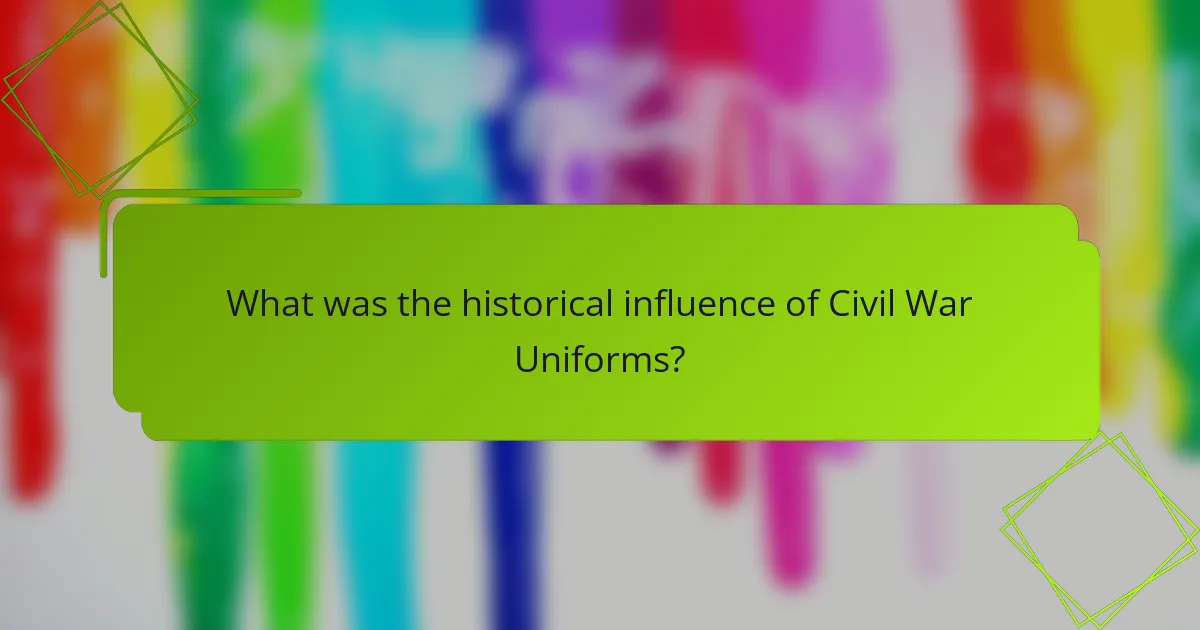
What was the historical influence of Civil War Uniforms?
Civil War uniforms significantly influenced military attire and national identity. They established standardized military dress codes in the United States. The distinct colors, such as Union blue and Confederate gray, symbolized loyalty and regional allegiance. These uniforms also fostered a sense of unity among soldiers. The designs influenced future military uniforms in various countries. The use of wool and cotton fabrics set precedents for material choices in military clothing. Additionally, the visual distinction between ranks through insignia became a standard practice. This standardization improved organization and communication on the battlefield. Overall, Civil War uniforms shaped both military tradition and American cultural identity.
How did Civil War Uniforms impact military practices in future conflicts?
Civil War uniforms significantly influenced military practices in subsequent conflicts. They established standardized designs that improved unit cohesion and identification. The use of distinct colors and insignia helped differentiate ranks and branches. This practice became a model for future military organizations worldwide. The emphasis on functionality in uniform design led to innovations in materials and tailoring. For example, the adoption of wool and cotton blends improved durability and comfort. The Civil War also highlighted the importance of uniformity for morale and discipline. These practices were later integrated into the uniforms of World War I and II armies. Overall, the legacy of Civil War uniforms shaped modern military attire and protocols.
What lessons were learned from the design and functionality of these uniforms?
The design and functionality of Civil War uniforms taught several important lessons. Firstly, the choice of materials affected durability and comfort. Wool was commonly used for its warmth and resilience. Secondly, uniformity in design aided in identification and morale. Soldiers felt a sense of belonging when wearing similar attire. Thirdly, rank indicators were essential for command structure. Different insignia allowed for quick recognition of leadership. Additionally, practical features like pockets and buttons improved functionality. These elements contributed to operational efficiency on the battlefield. Historical analysis shows that these lessons influenced future military uniform designs.
How did Civil War Uniforms influence modern military attire?
Civil War uniforms significantly influenced modern military attire by introducing standardized designs and color codes. The use of wool and cotton fabrics became prevalent, providing durability and comfort. Military branches adopted distinct colors to signify different units, a practice still in use today. The structured fit of Civil War uniforms set a precedent for modern tailoring in military clothing. Additionally, the incorporation of insignias for rank and unit identification began during this era. This system of rank indicators has evolved but remains integral to military uniforms. The emphasis on functionality and practicality in design during the Civil War laid the foundation for contemporary military attire.
What cultural significance do Civil War Uniforms hold today?
Civil War uniforms hold significant cultural importance today as symbols of American history and identity. These uniforms represent the sacrifices made during the Civil War, a pivotal event in U.S. history. They serve as educational tools in museums and reenactments, helping people understand the complexities of the conflict. The distinct designs and colors of the uniforms also reflect the regional identities of the North and South. Additionally, they are used in commemorative events, fostering discussions about unity and division in American society. The preservation of these uniforms in historical collections underscores their value as artifacts that connect contemporary society to its past.
How are Civil War Uniforms represented in popular culture and media?
Civil War uniforms are prominently represented in popular culture and media through films, television shows, and literature. Many films, such as “Gettysburg” and “Cold Mountain,” depict authentic Civil War uniforms to enhance historical accuracy. Television series like “The Civil War” by Ken Burns showcase these uniforms in documentary format, emphasizing their significance. Literature often describes the uniforms’ colors and materials, adding depth to character portrayals. Museums and reenactments further contribute by displaying replicas and original uniforms. The visual representation of these uniforms serves to educate audiences about their historical context and symbolism.
What role do reenactments play in preserving the history of Civil War Uniforms?
Reenactments play a significant role in preserving the history of Civil War uniforms. They provide a tangible experience of the past, allowing participants and audiences to engage with history. During these events, accurate reproductions of uniforms are worn, showcasing their material composition and design. This hands-on approach helps educate the public about the historical significance of these garments.
Reenactments also foster a deeper appreciation for the craftsmanship involved in creating Civil War uniforms. Participants often research the specific attributes of uniforms, including rank indicators and fabric types. This research contributes to a more accurate representation of the era.
Furthermore, reenactments create opportunities for dialogue about the Civil War’s impact on society. They encourage discussions around the social and political context of the uniforms worn. This engagement helps keep the memory of the Civil War alive and relevant for future generations.
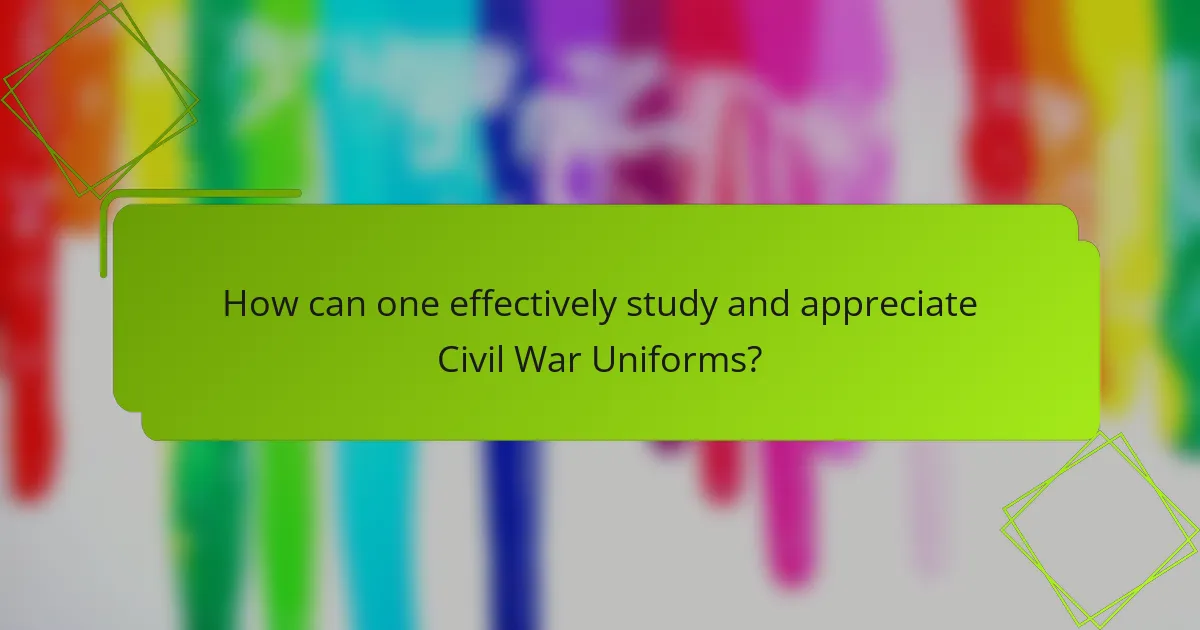
How can one effectively study and appreciate Civil War Uniforms?
To effectively study and appreciate Civil War uniforms, one should begin by researching their historical context. Understanding the significance of uniforms during the Civil War enhances appreciation. Examining the material composition reveals how they were made and their durability. Analyzing rank indicators helps identify the hierarchy within military units. Visiting museums or historical sites provides firsthand experience with original uniforms. Engaging with primary sources, such as letters or photographs, offers insights into soldiers’ perspectives. Joining reenactment groups allows for practical understanding of uniform usage. Reading scholarly articles or books on Civil War attire deepens knowledge. These approaches collectively foster a comprehensive understanding of Civil War uniforms and their cultural impact.
What resources are available for learning about Civil War Uniforms?
Books on Civil War uniforms include “Civil War Uniforms: A Pictorial History” by John P. Langellier. This book provides visual references and detailed descriptions of uniforms worn during the war. Online resources like the Civil War Trust offer articles and images related to uniforms. The National Park Service website also features historical information about the uniforms. Museums such as the Smithsonian and the Gettysburg Museum have exhibits showcasing original uniforms. Academic journals may publish articles on uniform studies, providing scholarly insights. Additionally, documentaries and educational videos on platforms like PBS explore the topic in depth.
Where can one find authentic examples of Civil War Uniforms?
Authentic examples of Civil War uniforms can be found in various historical museums and collections. Notable institutions include the Smithsonian National Museum of American History in Washington, D.C. They house a significant collection of Civil War artifacts. The Gettysburg Museum of History also features authentic uniforms on display. Additionally, the National Civil War Museum in Harrisburg, Pennsylvania showcases various military attire. Collectors and reenactment groups often have authentic pieces as well. Online auction sites and antique shops may also offer original uniforms for sale. These sources provide a comprehensive view of Civil War military attire.
How can museums and historical societies enhance understanding of Civil War Uniforms?
Museums and historical societies can enhance understanding of Civil War uniforms through detailed exhibitions. These exhibitions can showcase authentic uniforms, providing tangible context. They can also include interactive displays that allow visitors to touch and examine materials used. Educational programs can be developed to explain the significance of different uniform styles. Workshops can teach about the manufacturing processes and materials like wool and cotton. Guided tours can highlight rank indicators and their meanings. Collaborations with historians can deepen insights into uniforms’ historical influence. Additionally, digital resources can expand access to information about Civil War uniforms.
What practical tips can enhance the study of Civil War Uniforms?
To enhance the study of Civil War uniforms, focus on primary sources and historical documents. Analyzing official military records can provide insights into uniform regulations. Visiting museums with Civil War exhibits allows for direct observation of artifacts. Engaging with scholarly books and articles on military history offers detailed context. Joining reenactment groups can provide practical experience with uniforms. Attending lectures or seminars on the topic can deepen understanding. Utilizing online databases for research helps access a wide range of materials. Collaborating with historians or experts in the field can enhance knowledge and interpretation.
How can one engage with historical reenactments for deeper insight?
One can engage with historical reenactments by participating in events that focus on specific historical periods. This involvement allows individuals to experience the culture, clothing, and practices of the time. Attending reenactments provides firsthand observation of historical events and interactions. Engaging with knowledgeable reenactors enhances understanding of historical context and accuracy. Researching the specific era, such as the Civil War, can deepen one’s appreciation for the details presented. Observing uniform details, like material composition and rank indicators, offers insights into social structures and military organization. Participating in discussions or workshops at these events fosters a richer comprehension of historical narratives. Engaging with primary sources, like letters or diaries from that time, can further inform one’s perspective on the reenactment.
What are best practices for preserving and displaying Civil War Uniforms?
Best practices for preserving and displaying Civil War uniforms include controlling environmental conditions, using appropriate materials, and limiting handling. Maintain a stable temperature between 65-70°F and humidity levels around 40-50%. Use acid-free storage materials to prevent degradation. Display uniforms in UV-filtered cases to protect from light damage. Avoid using metal fasteners that can rust. Regularly inspect the uniforms for signs of deterioration. Ensure that handling is minimal and that cotton gloves are worn during any necessary handling. These methods help preserve the integrity and historical value of the uniforms.
Civil War uniforms are standardized clothing worn by soldiers during the American Civil War, serving critical functions such as identification, unity, and discipline. The article explores the evolution of these uniforms over time, detailing their initial designs, material composition, and the influence of climate and geography on fabric choices. It also examines rank indicators used to signify military hierarchy, the historical significance of these uniforms, and their lasting impact on modern military attire and practices. Additionally, the cultural significance of Civil War uniforms in contemporary society, including their representation in popular culture and the role of reenactments in preserving history, is discussed.
